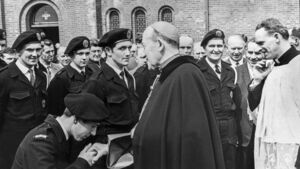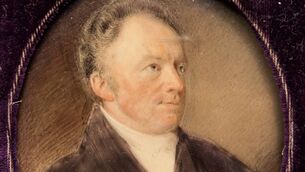Memories live on in Athy's Arthouse exhibition

Archbishop John Charles McQuaid at the opening of parish church in 1964. Fr Joe Corbett local curate next to him. Photo courtesy of Frank Taaffe
FOR a historian there are many windows into the past. Sources such as letters, diaries, and newspapers give us good records of our predecessors, but for me photography can give a vivid and intimate link to the past that is difficult to replicate anywhere else.
A simple image, whether in black and white, gives us a direct connection to people or events long past. I was reminded of this with the recent opening of the exhibition ‘Here Comes Everybody’ at Arthouse which is described as an art gallery and exhibition space in 42a Leinster Street. It is part of an ongoing initiative as part of the Creative Places programme running in Athy.
Though small, the exhibition was well presented with some fine reproductions of photographs of people and places in Athy over the last 80-100 years. Peering out from the photographs were faces of many people I had known in my youth who are now long gone, but their memory lives on in the photographic images which survive then.
There was one thing lacking from the exhibition which I think could add to its interest. None of the images that I viewed were captioned and while I could happily identify many people and places from the photographs, from a historian’s point of view it would add immeasurably to the exhibition if there was some guide or captions to the images on display. It’s a worthwhile endeavour and the exhibition itself will run until the middle of January.
Athy Photographic Society, which from my reckoning is now running for almost forty years, has released their annual photographic calendar. The 2025 edition is an interesting digression from previous calendars as rather than just simply featuring images of the town and locality this year, rather imaginatively, the society have used local images to recreate twelve iconic music album covers. It was nice to see the juxtaposition between local people and local places paying homage to classic music albums. My musical heritage is grounded in the music of the ‘50s and ‘60s and so many of the album covers featured meant little to me but I particularly enjoyed the recreation of the British rock band Jethro Tull’s album cover, ‘Songs from the Woods’.
One of the more curiously titled bands, their name derives from a pioneering English agriculturalist Jethro Tull who developed the horsedrawn seed drill in the early 18th century that revolutionised agriculture in providing farmers with a modern and economic method of sowing seeds in neat rows for tillage purposes. His master work on the subject The New Horse Houghing Husbandry: or, An essay on the principles of tillage and vegetation was published in Dublin in 1731 and it was one of the earliest works on agriculture published in Ireland at the time. This invention had a huge impact on both the economic life and landscape of south Kildare as Athy has some of the best tillage land in the country.
This is reflected in a detailed report on the agriculture of Athy and district published in the Leinster Leader on 26 March 1898. Athy’s agricultural economy was prospering and it seemed to have avoided the agricultural depression which dogged much of the country at the time. The article focused on the mills run by Messrs H. Hannon and Sons. The reporter interviewed the manager of the mills, a Mr Price, who treated the journalist to a detailed description of the milling process from the arrival of the raw product by barge on the Grand Canal to the final process of manufacturing. Mr Price paid particular tribute to the managing clerk, a Mr Dobbin and mentioned that twenty men were employed in the three mills.
The mills in Ardreigh and Prumplestown were focused on the manufacturing of flour, while the Athy mills were solely devoted to Indian meal. Much of the land around the town at that time was devoted to wheat growing. In 1897 the Prumplestown mills produced 9,338 barrels of wheat which were manufactured into flour while the Ardreigh mill produced 8,500 barrels of wheat which were manufactured into flours of various qualities.
The market for the produce was local and would have been sold in Carlow, Tullow, Baltinglass, Castledermot, Stradbally, Castlecomer, Monasterevin, Portarlington and Edenderry. Wheat from both mills was sold at one shilling and six pence per barrel. That price was apparently very good from a local farmers’ perspective. Sadly this prosperity was not to last as by the early 1920s imports of cheaper grain from the US devastated the grain industry to the point where none of the mills were operating by the late 1920s.





